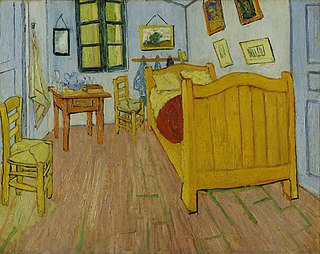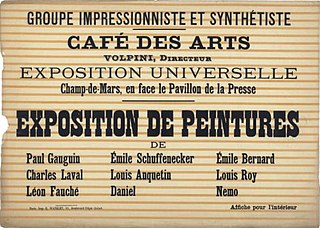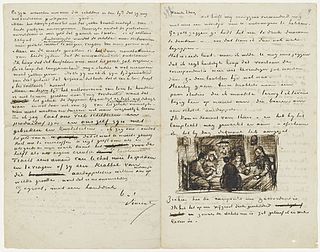See also
| This disambiguation page lists articles associated with the title The Siesta. If an internal link led you here, you may wish to change the link to point directly to the intended article. |
The Siesta may refer to:
| This disambiguation page lists articles associated with the title The Siesta. If an internal link led you here, you may wish to change the link to point directly to the intended article. |

Vincent Willem van Gogh was a Dutch post-impressionist painter who is among the most famous and influential figures in the history of Western art. In just over a decade, he created about 2,100 artworks, including around 860 oil paintings, most of which date from the last two years of his life. They include landscapes, still lifes, portraits and self-portraits, and are characterised by bold colours and dramatic, impulsive and expressive brushwork that contributed to the foundations of modern art. He was not commercially successful, and his suicide at 37 came after years of mental illness, depression and poverty.

The Musée d'Orsay is a museum in Paris, France, on the Left Bank of the Seine. It is housed in the former Gare d'Orsay, a Beaux-Arts railway station built between 1898 and 1900. The museum holds mainly French art dating from 1848 to 1914, including paintings, sculptures, furniture, and photography. It houses the largest collection of Impressionist and post-Impressionist masterpieces in the world, by painters including Monet, Manet, Degas, Renoir, Cézanne, Seurat, Sisley, Gauguin, and Van Gogh. Many of these works were held at the Galerie nationale du Jeu de Paume prior to the museum's opening in 1986. It is one of the largest art museums in Europe. Musée d'Orsay had more than 3.6 million visitors in 2019.

Sunflowers is the name of two series of still life paintings by the Dutch painter Vincent van Gogh. The first series, executed in Paris in 1887, depicts the flowers lying on the ground, while the second set, made a year later in Arles, shows a bouquet of sunflowers in a vase. In the artist's mind both sets were linked by the name of his friend Paul Gauguin, who acquired two of the Paris versions. About eight months later van Gogh hoped to welcome and to impress Gauguin again with Sunflowers, now part of the painted Décoration for the Yellow House that he prepared for the guestroom of his home in Arles, where Gauguin was supposed to stay. After Gauguin's departure, van Gogh imagined the two major versions as wings of the Berceuse Triptych, and finally he included them in his Les XX in Bruxelles exhibit.

Émile Henri Bernard was a French Post-Impressionist painter and writer, who had artistic friendships with Vincent van Gogh, Paul Gauguin and Eugène Boch, and at a later time, Paul Cézanne. Most of his notable work was accomplished at a young age, in the years 1886 through 1897. He is also associated with Cloisonnism and Synthetism, two late 19th-century art movements. Less known is Bernard's literary work, comprising plays, poetry, and art criticism as well as art historical statements that contain first-hand information on the crucial period of modern art to which Bernard had contributed.

Les Alyscamps is a pair of paintings ("pendants") by Dutch painter Vincent van Gogh. Painted in 1888 in Arles, France, it depicts autumnal scenes in the Alyscamps, an ancient Roman necropolis in Arles which is lined with poplars and stone sarcophagi.

Charles Laval was a French painter associated with the Synthetic movement and Pont-Aven School.

Fall of Leaves , or Falling Autumn Leaves is a pair of paintings by the Dutch painter Vincent van Gogh. They were executed during the two months at the end of 1888 that his artist friend Paul Gauguin spent with him at The Yellow House in Arles, France.

Bedroom in Arles is the title given to each of three similar paintings by 19th-century Dutch Post-Impressionist painter Vincent van Gogh.

L'Arlésienne, L'Arlésienne: Madame Ginoux, or Portrait of Madame Ginoux is the title given to a group of six similar paintings by Vincent van Gogh, painted in Arles, November 1888, and in Saint-Rémy, February 1890. L'Arlésienne means literally "the woman from Arles".

Les Arènes is a painting by Vincent van Gogh executed in Arles, in November or December 1888, during the period of time when Paul Gauguin was living with him in The Yellow House. The bullfight season in Arles that year started on Easter Sunday 1 April and ended on 21 October. Van Gogh's painting is therefore not a study from nature but done from memory. Gauguin encouraged van Gogh to work in the studio in this manner. The painting may not be finished as the paint is very thinly applied, and patches of bare jute show through in places.
Paul Gauguin's exhibit at Les XX in 1889 was the first important display of Paul Gauguin's works, and added to the recognition that he had begun to receive in 1888. The annual exhibition was organized by Les XX, and participation was by invitation only. Gauguin's exhibit comprised paintings from Martinique, Britanny and Arles. Many of these can be identified easily, but for several items the discussion is not yet closed.

The Painter of Sunflowers is a portrait of Vincent van Gogh by Paul Gauguin in December 1888.

The Volpini Exhibition was an exhibition of paintings arranged by Paul Gauguin and his circle held at the Café des Arts on the Champ de Mars, not far from the official art pavilion of the 1889 Exposition universelle in Paris. A poster and an illustrated catalogue were printed, but the show of "Paintings by the Impressionist and Synthetist Group", held in June and early July 1889, was ignored by the press and proved to be a failure.

Claude-Émile Schuffenecker was a French Post-Impressionist artist, painter, art teacher and art collector. A friend of Paul Gauguin and Odilon Redon, and one of the first collectors of works by Vincent van Gogh, Schuffenecker was instrumental in establishing The Volpini exhibition, in 1889. His own work, however, tends to have been neglected since his death—and even worse, recent season campaigns in the media have reactivated resentments virulent since the late 1920s, when Schuffenecker was suspected to have imitated the work of other contemporary artists, among them, Van Gogh. Still a contentious issue, it has not been established whether or not he produced forgeries. Meanwhile, serious scholarly research at least has provided the base for a sober historical approach to Schuffenecker's life and work.

The Letters of Vincent van Gogh refers to a collection of 903 surviving letters written (820) or received (83) by Vincent van Gogh. More than 650 of these were from Vincent to his brother Theo. The collection also includes letters van Gogh wrote to his sister Wil and other relatives, as well as between artists such as Paul Gauguin, Anthon van Rappard and Émile Bernard.

Road with Cypress and Star, also known as Country Road in Provence by Night, is an 1890 oil-on-canvas painting by Dutch post-Impressionist painter Vincent van Gogh. It is the last painting he made in Saint-Rémy-de-Provence, France. The painting is part of the large van Gogh collection of the Kröller-Müller Museum, located in the Hoge Veluwe National Park at Otterlo in the Netherlands.

Landscape near Arles is an 1888 oil painting by French artist Paul Gauguin, located in the Indianapolis Museum of Art, which is in Indianapolis, Indiana. It depicts a rural scene in Provence.

Memory of the Garden at Etten is an oil painting by Vincent van Gogh. It was executed in Arles around November 1888 and is in the collection of the Hermitage Museum. It was intended as decoration for his bedroom at the Yellow House.

Arearea is an 1892 work by French painter Paul Gauguin. It was one of the works Gauguin exhibited at his 1893 Durand-Ruel exhibition in Paris. It was bequeathed to the French state in 1961, and was in the collection of the Louvre. From 1986, the painting has been in the collection of the Musée d'Orsay. The prominence in his paintings of collarless free range dogs has been the subject of much speculation as to their symbolic or metaphorical meaning.

Self-Portrait with Halo and Snake, also known as Self-Portrait, is an 1889 oil on wood painting by French artist Paul Gauguin, which represents his late Brittany period in the fishing village of Le Pouldu in northwestern France. No longer comfortable with Pont-Aven, Gauguin moved on to Le Pouldu with his friend and student Meijer de Haan and a small group of artists. He stayed for several months in the autumn of 1889 and the summer of 1890, where the group spent their time decorating the interior of Marie Henry's inn with every major type of art work. Gauguin painted his Self-Portrait in the dining room with its companion piece, Portrait of Jacob Meyer de Haan (1889).